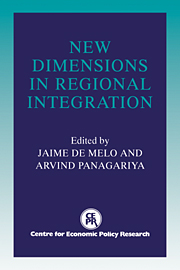Book contents
- Frontmatter
- Contents
- List of figures
- List of tables
- Preface
- Foreword
- Acknowledgements
- List of conference participants
- PART ONE SYSTEMIC ISSUES
- PART TWO COUNTRY ISSUES
- 6 The new regionalism: a country perspective
- Discussion
- 7 The European Community: a case of successful integration?
- Discussion
- 8 Regional integration in Sub-Saharan Africa: past experience and future prospects
- Discussion
- 9 Latin America's integration and the multilateral trading system
- Discussion
- 10 Regional integration in Eastern Europe: prospects for integration within the region and with the European Community
- Discussion
- 11 Regional trade arrangements in North America: CUSTA and NAFTA
- Discussion
- 12 Trading blocs and East Asia
- Discussion
- 13 Prospects for regional integration in the Middle East
- Discussion
- Round Table Discussion
- Index
12 - Trading blocs and East Asia
Published online by Cambridge University Press: 04 May 2010
- Frontmatter
- Contents
- List of figures
- List of tables
- Preface
- Foreword
- Acknowledgements
- List of conference participants
- PART ONE SYSTEMIC ISSUES
- PART TWO COUNTRY ISSUES
- 6 The new regionalism: a country perspective
- Discussion
- 7 The European Community: a case of successful integration?
- Discussion
- 8 Regional integration in Sub-Saharan Africa: past experience and future prospects
- Discussion
- 9 Latin America's integration and the multilateral trading system
- Discussion
- 10 Regional integration in Eastern Europe: prospects for integration within the region and with the European Community
- Discussion
- 11 Regional trade arrangements in North America: CUSTA and NAFTA
- Discussion
- 12 Trading blocs and East Asia
- Discussion
- 13 Prospects for regional integration in the Middle East
- Discussion
- Round Table Discussion
- Index
Summary
At a time when large political and economic agglomerations like the USSR, Yugoslavia and Czecho-Slovakia have broken up, great confidence in strong customs unions (CUs) being the way of everyone's future seems a bit misplaced. Indeed, it is possible to argue that it is the extraordinary success of small East Asian entities like Hong Kong and Singapore within the GATT-governed multilateral trading system that now emboldens Croatians, Azerbaijanis, Latvians and Slovaks to assume that political independence need not mean economic disaster. It is possible to believe that a well-functioning, open multilateral trading system makes continental superpowers that run roughshod over cultural diversity anachronistic. With the multilateral trading system capable of substituting for much of the special economic advantages of large political size, the door might be viewed as potentially open for a plethora of economically viable microstates organised, perhaps in the East Asian image, on the basis of cultural affinity.
While liberal systems could make the world safe for cultural diversity, exclusivity does raise its ugly head. Croatians who believe that the GATT provides the economic charter for their political liberty may be in for a nasty surprise when they negotiate the terms of their access to Europe's so-called Single Market. Of course, it is the new vitality of regional arrangements such as the European Community and the North American Free-Trade Area (NAFTA) and prospective arrangements in East Asia, and not the obsolescence of dinosaurs like the USSR, that provide the context for this chapter.
- Type
- Chapter
- Information
- New Dimensions in Regional Integration , pp. 388 - 416Publisher: Cambridge University PressPrint publication year: 1993
- 8
- Cited by

